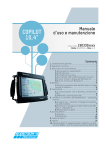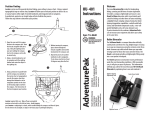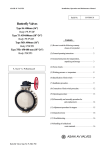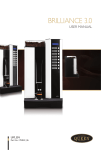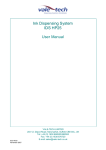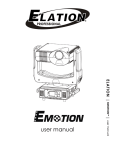Download Sigma 150-600mm F5-6.3 DG OS HSM Sport A hands
Transcript
Sigma 150-600mm F5-6.3 DG OS HSM Sport A hands-on field review – Part 1 All Text and Photos © SimonDP/Actionimage 2015 ( web: www.actionimage.co.za email: [email protected]) Introduction The range of 150-500mm zoom lenses or its close derivatives have always been very popular amongst photographers and especially those who are on a tighter budget and cannot justify the expense for a 500mm or 600mm f4 prime lens. Offering slower maximum apertures typically at f6.3, these lenses gave the enthusiast the perfect alternative to expensive fast prime or super tele zoom lenses. Now this range has been expanded with at least two manufacturers adding a 150-600, f5-6.3 lens in their line-up which adds an extra 100mm of reach and offering them at a very reasonable price too, around R14,000.00 Which brings us to this lens on review, priced at around R24,000.00 at the time of writing this, it is about R10,000.00 more expensive than its main competitor and also its own cheaper stable mate, the 150-600 f5-6.3 Contemporary lens in the Sigma line-up. The question immediately arises; is it worth it? I aimed to find out for myself. This review will be a two parts, Part 1 dealing with the general specifications, in the hand comments, and the results from the initial birding and wildlife test sessions. Part 2 will handle with lens used in a sports environment and specifically cricket and motorsport, customization using the optional USB Dock, follow-up testing and final conclusions. Specifications Since the Sigma 150-600mm f5-6.3 DG OS HSM Sport lens (hereafter referred to as 150-600 Sport) is of a different design to the Sigma 150-600 Contemporary lens, I will show their respective specifications side-by-side for easy comparison. From this it can easily be seen that the 150-600 Sport is bigger and most certainly also heavier than its Contemporary stable mate, Specification Lens Construction Angle of View Number of Diaphragm Blades Mininum Aperture Minimum Focusing Distance Filter Size (mm) Maximum Magnifications Dimensions (Diameter x Length) Weight 150-600 Sport 24 Elements in 16 Groups 16.4º-4.1º 9 150-600 Contemporary 20 Elements in 14 Groups 16.4º-4.1º 9 f22 f22 260cm/ 102.4 in 280 cm / 110.2 in 105mm 1:5 95mm 1:5 121x290.2mm/ 4.8x11.4in 105x260.1mm/ 4.1x10.2in 2860g/ 100.9oz Unknown Controls of the 150-600 Sport: Zoom Lock Switch on the left. On the right, top to bottom is the Focus Mode Switch AF/MO/MF, Focus Limiter Switch, Optical Stabiliser Switch, Custom Selector Switch. Also shown to the right of the switch panel is the Twist Knob for the tripod mounting ring, and the bracket for the attachment of a lens strap. A Zoom Lock is fitted which securely locks the lens at 150mm for transport purposes, and can also be set at full 100mm zoom settings to assist in accidentally slightly moving off the required zoom setting. I found this to be quite useful as I did manage to accidentally take few shots at 569mm believing the lens was at maximum zoom, such as the photo of the galloping Black Wildebeest with her calf. When set at these 100mm intervals it can however be disengaged (except for the 150 lock setting) with a slightly firmer twist of the knurled zoom ring. The zoom ring operates smoothly with an anti-clockwise rotation to zoom from 150 to 600mm. Zoom creep occurs when the lens is pointed down or up with the lock disengaged. Black Wildebeest and Calf Focus mode switch AF/MO/MF: Offers not only the standard auto focus (AF) and manual focus (MF) modes, but also MO which is Manual Override allowing the manual focus ring to be operated even when the focus is on continuous AF mode. How often this will be used remains to be seen, I didn’t find the need to use this feature, but as usual it’s nice to know it’s there if you need it. An ultrasonic type focus motor that Sigma calls HSM (Hyper-Sonic Motor) for a fast and quiet AF function is standard for this lens. A focus limiter switch is fitted, providing settings of 2.6m – 10m, 10m – infinity, and the full focus range. Optical Stabiliser Switch: A two stage OS is included: Mode 1: Normal OS in both horizontal and vertical planes Mode 2: Panning mode – OS in the vertical plane only Also fitted is a special Custom Selector Switch: using the USB Dock (sold separately, and which basically looks like a rear lens cap with electronic contacts and a USM cable) with the free Sigma Optimization Pro software the user can update the firmware of the lens and add custom settings to his lens setup for AF, OS function and focus range. Different settings can be stored in two memories, C1 and C2. A very sturdy, non-removable tripod mounting collar is supplied with click settings at right angles, enabling the lens to rotate easily to the desired orientation. The lens tightens securely in the collar with the familiar twist knob operation. USB Dock Mass: If the user upgrades from any 70-300 or 70-200 f2.8 or similar lens, then this 150-600 Sport lens will feel very intimidating in the hand. It is a heavier lens than what most will be accustomed to. But the weight is not too much to handle; I did a fair amount of handheld shots with this lens. Size: With the metallic alloy lens hood fitted and zoomed in to 150 mm it is a relative compact 394mm but when at 600mm the difference is substantial as one would expect it to be, 474mm. Still the lens is not overly bulky and definitely within the bulk parameters for lenses of this nature. In the sturdy cardboard box the buyer will find his lens with lens caps front and rear, lens hood, padded neoprene carry case and a lens strap. An information sheet which doubles as a user manual with all relevant info and warnings is also provided. In the hand I prefer using a monopod with the big lenses when covering sporting events or doing birding photography on foot. However the mass of this lens wasn’t all that serious for me, being used to the Sigma 120-300 f2.8 and the Canon 500 f4 L IS USM lenses. I suspect the first time big lens owner might disagree with me here though. I ended up doing a lot of the birding and wildlife photos handholding the lens in good light conditions where I could get the shutter speed up and relied on the OS for the safety margin in avoiding camera shake. In not so good lighting environment the OS did its part and neutralised camera shake very effectively, as shown by the shot of the crab, taken whilst handholding the lens with a shutter speed of 1/100 on a 600mm focal length and using the OS in mode 1. That is very good performance indeed. Crab on the rocks (handheld, OS, slow shutter speed) I did notice that the OS stopped working when the camera’s battery dropped to below ¼ charge at which time I reverted back to using the monopod out in the field until I could get the battery charged up again. Using the lens with my “monopod in belt pouch technique” is a very stable way to handle the long lenses even at slower shutter speeds. All it takes is a proper holding technique and lots of practice. It also helps to keep the weight of the camera and lens combination off the shoulders, neck and arm muscles, which is very conducive to stability and endurance during extended sessions with the bigger, heavier tele-zoom lenses. Another feature that I liked was the relatively short minimum focussing distance of 2.6 m, which makes it possible to get tighter framed shots of smaller subjects closer to the camera, such as the lizard on the rocks basking in the sun. The true aim of this review is to report on the performance of the lens in the field, photographing different sporting events and also using it in a birding and wildlife environment. Lined up was a test to visually check calibration of the lens to my Canon EOS 1D MkIV and older 1D MkII camera bodies. The field evaluation would encompass cricket matches, some motorsport and also birding and wildlife. Sunbathing lizard (handheld) Calibration The focus accuracy of the lens proved to be spot-on with both the camera bodies I tested it on and exhibited no front or back focus issues at any zoom range. I still connected the USB dock thoughtfully provided by TudorTech and could easily update the firmware of the lens to the latest version. I kept all the adjustable settings using the Sigma Optimization Pro software on the default setting. More on this later in the review. Birding and Wildlife Day trips out to nature and birding reserves and taking the lens with me on holiday to the coast provided ample opportunities to test the focus tracking of the lens on static and moving nature subjects, specifically birds in flight and animals doing some form of activity. The versatility of the lens immediately showed itself in this environment, the very handy zoom range offering multiple framing opportunities to the photographer as shown by the herd of Eland, first taken at 150mm and then zoomed in to 600mm. The pulling power of the lens is certainly a huge bonus. Herd of Eland Waterbuck Little Egret The wildlife that walked out in front of my lens were captured as good as can be expected at this stage, the shots of more static subjects offering lots of detail and colour proving the lens to be a very capable performer delivering a 90%+ keeper rate. Photos showed good colour and detail when used at slow shutter speed from a beanbag such as the shot of a Waterbuck, a rather shy animal and not seen in the open all that often. Moments after taking this photo, they disappeared into the bushes. A Little Egret I found fishing in a shallow stream showed good detail even though the frame was captured at maximum zoom and aperture wide open, which came as bit of a surprise as many lenses not regarded as true professional products need to be stopped down one stop or so for best results, usually being a little soft when used wide open. The results from panning birds and animals in motion yielded no surprises with an acceptable high keeper rate of about 70% on sharply focussed images, mostly using a monopod or bean bag. When slow shutter speeds were the norm the OS was used in mode 2. The panned photo of the fast running White-fronted Plover on the beach was taken handheld. The slower moving head-on focus tracking performed well enough, as the fast swimming Yellow-billed Duck exhibits good focus and detail. With the first head-on birds in flight tests the keeper rate dropped to below 40% and lower still on fast flying birds straight towards the camera which is a quite severe test for any lens. White-fronted Plover Yellow-billed Duck Right now I have to say that this series of tests were done in parallel to the main “opposition manufacturer’s” lens, shooting them side-by side under the same conditions from the same camera body. That lens is also a 150-600 f5-6.3 lens, with only one stabilisation mode, really a competition to Sigma’s 150-600 Contemporary lens priced at approximately R10,000.00 cheaper than this 150-600 Sport,. The 150-600 Sport lens overshadowed the results from the other manufacturer’s lens in all aspects as is shown in the table below. The scores are based on a scale of 1 to 10, where 10 will be the reference score for the winning lens in relation to the competitor. Assigning 10 does not imply perfect performance in all respects, only a comparison reference score for this side-by-side test!! Test Parameter Static subject AF in lower light levels IQ at 600mm f6.3 IQ at 600 f8 Panning AF in good light conditions Tracking AF, head-on movement, good light conditions, fast or erratic flying subjects Sigma 150-600 Sport 10 (Very good with accurate lock-on) 10 (No need to stop down for better results) 10 (Still very good) 10 (Accurate enough for this class of lens, offering about 70% keepers) 6 (Before USB dock AF adjustment, offering about 35% keepers) 10 (after USB dock adjustment, offering about 70% keepers Other Manufacturer 150-600 8 (Good, some hunting before lock-on from time to time) 7 (works better at f8) 9 (Noticeably better IQ but still lagging slightly in crisp sharpness at full size) 7 (Can provide acceptable results, but missing some opportunities) 4 (Keeper rate only about 20 percent on faster moving birds in flight, which was rather disappointing) 4 (no option for custom setup) Unfortunately (or fortunately depending on your point of view) no big animal charged me so I couldn’t evaluate the wildlife head-on AF performance, but I am quite sure the results from a very brave me would have indicated similar performance to the birds in flight tests. In part 2 of this review I will be discussing the results from the testing in a Sports environment, using cricket and motorsport, and formulate my final conclusions. In the iterim - Many thanks to TudorTech (+27 11 803 2226) for arranging and making available the test lens and USB Dock.














